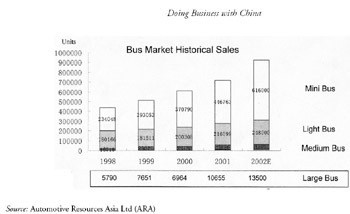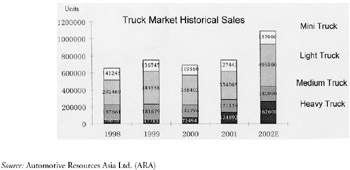Chapter 6.3: Commercial Vehicles
Mark Norcliffe, Society of Motor Manufacturers and Traders, and Jonathan Reuvid
Market growth
The Chinese commercial vehicle industry consists of two main segments of buses and trucks , further divided into four categories of bus and four of truck. As Table 6.3.1 shows, overall growth in both these segments since 1998 has been strong, following a similar pattern in the expanding passenger car market.
| Year | Trucks | Buses |
|---|---|---|
| 1998 | 867,648 | 436,719 |
| 1999 | 1,014931 | 511,291 |
| 2000 | 1,213,400 | 610.182 |
| 2001 | 1,424,151 | 717,403 |
| 2002 (estimated) | 1,835,500 | 924,500 |
| Source: Automotive Resources Asia Ltd. (ARA) | ||
The Chinese bus market is currently the largest in the world and in 2001 truck sales accounted for 51 per cent of the total Asian truck market.
Segmentation
Within the bus and truck sectors, patterns of growth and the proportion of buses to trucks differ significantly. Figure 6.3.1 shows historical sales in the bus market and Figure 6.3.2 historical sales of each of the four categories of truck.

Figure 6.3.1: Bus market historical sales (units)

Figure 6.3.2: Truck market historical sales (units)
There is a significant contrast between the development of the bus and truck sectors in terms of their relative sophistication. While improved infrastructure and more long distance travel are drivers for the expansion of both markets, the bus sector is progressing more rapidly because of consumers' demands for greater comfort . In the truck sector, where a driver can be hired for a few dollars a day, comfort is not a factor and price remains king. As a result, the traditional Big Two domestic manufacturers, FAW and Dong Feng, continue to dominate the truck sector with very cheap, basic products. Not surprisingly, imported trucks account for less than 1.5 per cent of the Chinese market.
Buses
The minibus, defined as a passenger mini vehicle less than 3.5 metres long, remains the most popular category in the bus segment and accounts for two- thirds of the total bus market. Between 1998 and 2002 unit sales increased by a factor of 2.5. Built mostly on Japanese technology, typically single-box and powered by 800cc engines, minibuses are money-making tools for people in small and medium- sized towns and are purchased by single people or consortia of private buyers .
Light buses, 3.5 “7 metres long and typically seating 11 “25, account for 27 per cent of the bus market and their sales have grown by 38 per cent since 1998. The principal purchasers of small buses are local taxi companies, either private or state-owned, who operate for hire, and individual companies who use the vehicles to transport employees to/from the workplace.
Medium-sized buses are 7 “10 metres long and include 'urban buses' used for inner city public transport; these account for a further 5 per cent market share. They comprise two distinct sub-sectors, with ownership of higher quality vehicles largely in the hands of State-Owned Enterprises (SOEs), while the 'urban' buses which provide local mass transportation are owned by local municipalities and cities. Outside the most prosperous major cities, urban buses are normally poor quality products.
Large buses over 10 metres long, with projected sales of 13,500, represent less than 1.5 per cent. The majority of coaches used on inter-city transport routes and in the tourist trade are operated by SOEs. Previously, only SOEs have been able to access funds to make cash purchases. However, more private companies are likely to enter the market as bank loans for vehicle purchase become more readily available.
Any assessment of purchasing patterns should recognize the strong municipal and provincial ties existing in China, particularly in the business relations of SOEs who give preference to locally manufactured products (eg the TAIC Juali Minibus predominating in Tianjin).
Trucks
Light trucks (GW 1.8 to 6 tonnes) are the major sector of the truck market with a share of 37 per cent, and sales have grown 69 per cent since 1998. This includes the traditional Chinese 5 tonne medium truck.
Sales in the medium truck sector (GW 6 to 14 tonnes) declined between 1998 and 2001 by 20 per cent but have revived in 2002 and are expected to gain almost 10 per cent of the market. By contrast, the mini truck sector (less than GW 1.8 tonnes) holds a dwindling share of the market, down from 16.3 per cent in 1998 to a projected 8.5 per cent in 2002.
However, the fastest growing sector is in heavy trucks (GW 14 tons or more), with a projected market share for 2002 of 14.2 per cent, where sales have grown by a factor of more than 4.2 since 1998 and are forecast to have almost doubled by the end of 2002.
While the percentage of heavy duty trucks in the total vehicle population is considered to be too small by industry commentators, five stimuli have been identified for the continued rapid development of China's heavy duty truck industry and market:
-
Preferential monetary policies from central government to stimulate purchasing;
-
Developing West Drive investment on infrastructure and flourishing real estate have increased demand (the officially backed policy to open up western China);
-
Customer benefits from the greater efficiency of heavy trucks;
-
Government crackdowns on the illegal overloading of transportation and illegal truck manufacture;
-
The upgrading of truck makers and diversified product lineups to attract more customers.
A further factor in the increasing use of road freight, also favouring larger capacity trucks, is the steady increase in classified national highways. Since 1994, the total mileage of paved highway has increased from just under 1 million kilometres to 1.3 million in 2000, of which expressways and Class 1 to 3 roads now account for 466,000 kilometres.
EAN: 2147483647
Pages: 648